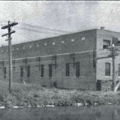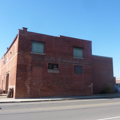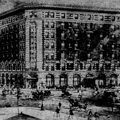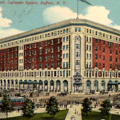Over the last two decades, Louise Blanchard Bethune has increasingly gained recognition as the first professional female architect in America, although she may not have appreciated that kind of attention during her lifetime. She was the first woman to be admitted to the American Institute of Architects (AIA). She was the first, and appears to have been the only, female principal in an architecture firm in America during the nineteenth century. Her professionalism helped pave the way for subsequent generations of women architects including Lois Lilley Howe, Josephine Wright Chapman, Sophia Hayden, Mary Nevan Gannon, Alice Hands, Julia Morgan, and Beverly Greene. By the time Bethune died in December 1915, nearly 200 women were practicing architecture in the United States.
Bethune’s priority was the doing the work of design, rather than explicit activism about the rightful place of women in the architectural profession. Her form of activism, though she may not have called it that, was design itself. Her buildings were similarly marked by a number of “firsts.” Bethune’s designs for over a dozen schools set the standards for the New York State school system several years before the field of architecture came to a consensus about the system’s needs. In 1896 she designed the first alternating current transformer station in the world, for Nikola Tesla’s pioneering electric system. Her firm’s 1908 design for a store in Buffalo was one of the first buildings in the nation to incorporate steel-frame construction and poured concrete slabs. She tackled educational and industrial projects with a keen sense of materials, efficiency, and a sophisticated understanding of their needs. Her pioneering contribution to the history of architecture was not merely the ways she was the first woman professionally recognized in the field, but her work itself.
Louise Blanchard was the only child of two schoolteachers. Her parents moved her to Buffalo from Waterloo, New York, in 1871, seeking better educational and professional opportunities for themselves as well as for her. At that time, Buffalo was a booming industrial city and emerging cultural center, situated at a confluence of rail lines, the Erie Canal, and Lake Erie. Money flowed in from the grain, shipping, manufacturing, and railroad industries, flowing back out into many large commercial, industrial, civic, and residential buildings during the late nineteenth century. In her first years in Buffalo, Bethune completed high school in the city’s public school system, where her father also taught. She considered attending the newly established four-year architecture program at Cornell University, one of the first of its kind. Instead, she chose to continue her education through an apprenticeship, a typical path for many architects since the 1850s.
In 1876, Bethune began working in the office of architect Richard Waite, in addition to working part-time for E.W. Caulkins. Waite had risen to near celebrity status in Buffalo by this time and was designing several large commissions when Bethune joined him. Her time in Waite’s office proved to be influential to her career as well as her personal life. It was there that she met her husband, Robert Bethune, an experienced draftsman who had previously trained in England and worked in Michigan. This meeting, as coworkers in 1878, led to both their marriage and their business together.
Louise and Robert left Waite’s office and launched their own architecture firm in 1881, R.A. and L. Bethune. Her career advanced, rather than ended, when she married Robert two months later in 1881 and had a child, Charles, in 1883. Later joined by William Fuchs to become Bethune, Bethune, and Fuchs in 1891, the firm was among the most successful in Buffalo during its tenure. Bethune, then 25 at the time, did not merely work at the firm, but was an owner and partner in it. The firm was among the most competitive and profitable in Buffalo. Bethune was known to be a savvy entrepreneur, managing the firm’s accounting, paperwork, and client relationships. She was not merely an office administrator, however, as she also was the lead architect for one-half to one-third of the firm’s commissioned buildings.
Although she is celebrated today as a “first” by many feminists and historians, Bethune herself preferred to do the work rather than advocate about her right to do so. She identified as a businesswoman, not a feminist, at a time when the two may have seemed mutually exclusive. She distinguished between these two roles, stating, “The objects of the businesswoman are quite distinct from those of the professional agitator. Her aims are conservative rather than aggressive; her strength lies in adaptability, not in reform, and her desire is to conciliate rather than to antagonize.” Bethune’s mother was related to Jane Hunt, one of the organizers of the 1848 Seneca Falls Convention. She likely had some sense of respect and reverence for this legacy of advocacy as well as her own contemporaneous reformers, even dignifying their unpaid work as “professional.” Yet even as the first and only woman officially accepted into the male profession of architecture in the 1880s, Bethune conveyed more of an interest in the field itself than in the field of reform. Through both her work and her words, she focused on how to be a good architect and successful business owner, rather than explicitly a reformer.
Bethune did advocate, however, for her rightful place alongside the male members of prominent professional architectural associations. In 1885, she became the first woman member of the Western Association of Architects (WAA), a group that challenged the standards set forth by the well-established American Institute of Architects (AIA). One year later, she founded the Buffalo Society of Architects, a group consisting mostly of male architects, which became the local AIA chapter in 1890. In 1888, she became the first woman member of the AIA itself. Several prominent male architects supported her application to AIA membership, including Louis Sullivan, Daniel Burnham, and John Root. All of these architects would also design important commissions in Buffalo during the mid-1890s, over a decade after Bethune’s firm had been established.
Her position as a recognized, official member of the AIA gave her leverage to criticize some of those same architects for their approach to the 1893 World’s Columbian Exposition in Chicago. Most of the major buildings for that world’s fair were designed by well-known AIA members such as Daniel Burnham, John Root, William Le Baron Jenney, Charles McKim, Richard Morris Hunt, George B. Post, and Louis Sullivan, with Burnham and Root serving as directors of the Building Committee. The Committee desired a female architect for the Woman’s Building, and thus delegated the choice to the fair’s Board of Lady Managers. This group of over 100 women, many of them socialites and wives rather than professionals, were unable to agree on a choice and held a design competition for the commission instead.
Bethune not only refused to participate in the competition, but also openly lambasted the competition process and financing in a speech made at the Women’s Educational and Industrial Union in March 1891. The award had been set at $1,000 for the design, one-tenth of the $10,000 award for the other male architect–designed fair buildings. For Bethune, this amount was not only insulting, but also impractical. The typical cost of her residential designs, for instance, was about $6,500, and her schools and factories were typically over $10,000. In light of this, Bethune was well aware that this award was less than the standard payment for typical architectural services. Her argument for equal pay still resonates with many women architects, and women in general, in today’s professional world. Bethune may not have grounded her thinking in this as a feminist issue, but instead, as scholar Johanna Hays has suggested, as a professional one that evoked the AIA principle of equal pay and ethical treatment of all architects.
Her criticisms extended into the competition format itself. Calling the design competition an “an evil against which the entire profession has striven for years,” Bethune spoke against the Woman’s Building competition not just as a woman, but as a professional architect and member of the AIA. By this time, the AIA opposed juried competitions due to a variety of reasons including favoritism, budget considerations, and efforts to balance practical elements over purely aesthetic qualities. Bethune’s speech garnered much attention from the AIA, from the press, and later from scholars during the late twentieth century. She, of course, did not design the Woman’s Building at the Chicago fair; that award was given to Sophia Hayden. Bethune “was definitely angry, irritated, and a little heartbroken” over her decision not to participate, as scholar Kelly Hayes McAlonie has stated. Bethune’s career was inextricably linked with the building nonetheless, making her mark through her speech and other designs instead.
Back in Western New York, Bethune achieved substantial success with her firm. She designed a remarkable variety of building types in Buffalo and throughout Erie and Niagara counties. At her firm, she designed eighteen schools, over ten commercial buildings, three hotels, and at least six factories, four liveries, and about a dozen residences. Despite her distaste for residential designs, most of her buildings that survive today are houses. Nearly all of her schools have been demolished or altered beyond recognition. Others, such as the Lafayette Hotel, have been recently rehabilitated, dredging up Bethune’s significance in recent press. The process of defining and celebrating that significance, however, is still ongoing.
References
Allaback, S. The First American Women Architects. Urbana: University of Illinois Press, 2008.
Barbasch, Adriana. “Louise Blanchard Bethune: The AIA Accepts Its First Woman Member.” In Architecture: A Place for Women, edited by Ellen Perry Berkeley, 15–25. Washington, D.C.: Smithsonian Institution Press, 1989.
Bethune, Louise. “Women and Architecture.” Inland Architect and News Record 17 (March 1891): 20–21.
“Bethune, Louise.” Who’s Who in New York City and State 4 (1909): 117.
Blank, Carla, and Tania Martin. Storming the Old Boys’ Citadel: Two Pioneer Women Architects of Nineteenth Century North America. Montreal: Baraka Books, 2014.
Dinerman, Barbara. “Women in Architecture.” Architectural Forum 13 (December 1969): 50–51.
Franklin, Sydney. “Overlooked No More: Louise Blanchard Bethune, Who Changed the Face of Buffalo.” New York Times, November 4, 2021.
Hays, Johanna. Louise Blanchard Bethune: America’s First Female Professional Architect. Jefferson, NC: McFarland & Company, Inc., 2014.
Herringshaw, T.W. “Bethune, Mrs. Louise B.” In Herringshaw’s National Library of American Biography. Chicago: American Publishers’ Association, 1909–1914.
McAlonie, Kelly Hayes. “Louise Bethune: America’s First Woman Architect.” Buffalo Spree Special Architectural Issue: Saving the Past and Building the Future. Buffalo, NY: Buffalo Spree Pub. Inc., 2006.
Stern, M.B. We the Women: Career Firsts of Nineteenth-Century America. New York: Schultz Publishing Company, 1963.
Willard, Frances E., and Mary Livermore. A Woman of the Century: Fourteen Hundred-Seventy Biographical Sketches Accompanied By Portraits of Leading American Women in All Walks of Life. Buffalo, NY: Charles Wells Moulton, 1893.
“Women Architects.” Buffalo Daily Courier (Buffalo, NY), March 7, 1891, 6.
Writing Credits
If SAH Archipedia has been useful to you, please consider supporting it.
SAH Archipedia tells the story of the United States through its buildings, landscapes, and cities. This freely available resource empowers the public with authoritative knowledge that deepens their understanding and appreciation of the built environment. But the Society of Architectural Historians, which created SAH Archipedia with University of Virginia Press, needs your support to maintain the high-caliber research, writing, photography, cartography, editing, design, and programming that make SAH Archipedia a trusted online resource available to all who value the history of place, heritage tourism, and learning.












